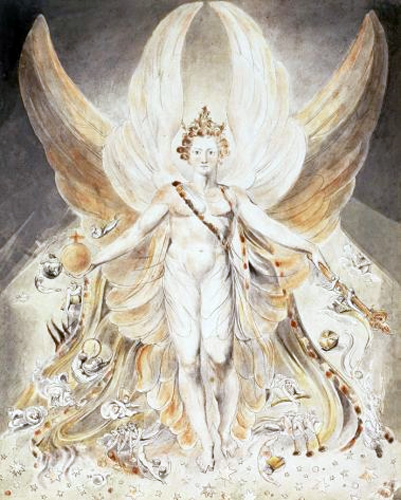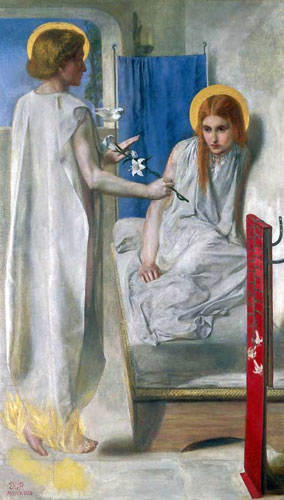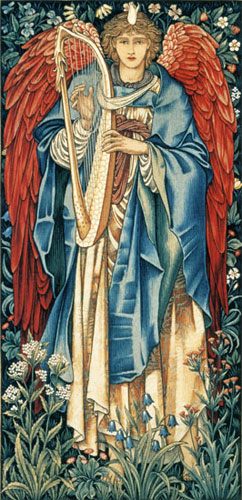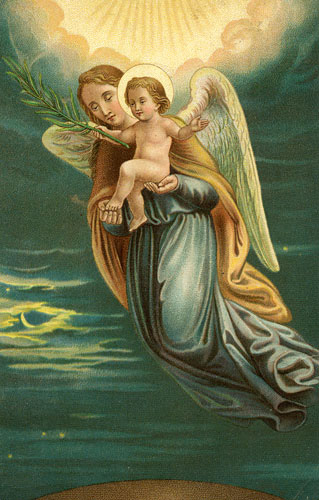At the close of the previous article [Angel Art – Part 2] I ventured to express the opinion that we should find the most successful modern artists who have pictured the angelic form to be those who have worked in the same simple spiritual manner as did the Pre-Raphaelite Italian painters. The religious ideal in art has been seldom attained: it demands something more than mere technical skill: the quietude of life, the purity of thought, the calm faith which Fra Angelico cultivated, are needed to produce the proper state of mind to direct the physical power of the work. There have been many modern painters who have set themselves to paint religious pictures, but those to whom success can be attributed are few.
Some there are who condemn the effort to delineate the physically unseen. Materialists themselves, they deny the right to others of finer susceptibilities to see visions and dream dreams. The imaginative faculty, however, properly exercised and controlled, combined with due facility of expression, is capable of doing great things in art; and in no direction can this faculty have greater play, or demand greater technical skill, than in the picturing of angels.
Mr. Ruskin treats fully of this matter in one of the chapters of “Modern Painters,” and the following passage dealing with this point is of great interest:—
“There is one true form of religious art, nevertheless, in the pictures of the passionate ideal which represent imaginary beings of another world. Since it is evidently right that we should try to imagine the glories of the next world, and as this imagination must be, in each separate mind, more or less different, and unconfined by any laws of material fact, the passionate ideal has not only full scope here, but it becomes our duty to urge its powers to its utmost, so that every condition of beautiful form and colour may he employed to invest these scenes with greater delightfulness (the whole being, of course, received as an assertion of possibility, not of absolute fact). All the paradises imagined by the religious painters— the choirs of glorified saints, angels, and spiritual powers, when painted with the full belief in this possibility of their existence, are true ideals: and so far from our having dwelt on these too much, I believe, rather, we have not trusted them enough, nor accepted them enough, as possible statements of most precious truths. Nothing but unmixed good can accrue, to my mind, from the contemplation of the scenes laid in Heaven by faithful religious masters: and the more they are considered, not as works of art, but as real visions of real things, more or less imperfectly set down, the more good will be got by dwelling upon them.”
Modern pictorial angels have, of course, for the most part figured in illustrations of Bible stories, and, as a rule, have been drawn strictly on conventional lines, and on this account, therefore, I shall omit references to many artists, reserving the greater space for those who demand it by their greater imaginative faculty.

Satan in his Original Glory by William Blake
To many, doubtless, the name of William Blake is familiar; but few are acquainted with the curious temperament and character of the man. His work, too, is probably unknown to many, but those who saw a collection of his drawings at the winter exhibition of the Royal Academy a few years ago must have been struck with the curious originality, amounting almost to eccentricity, of his illustrations of Bible incidents. He was a man distinctly in advance of his times—he lived towards the close of the last century—and was possessed of a mind always dwelling upon the mysteries of the unseen. When but eight years of age he declared that he saw angels in the trees on Peckham Rye, thereby incurring his father’s displeasure to the extent of a threatened flogging, and in his after-life his imagination ran far ahead of the powers of his pencil. But he believed firmly in his visions, and religious faith was the foundation of his life. On one occasion a young artist complained to him that at times his inventive faculties appeared to vanish.
“It is just so with us, is it not,” replied Blake, turning to his wife, “for weeks together, when the visions forsake us? What do we do then, Kate?”
“We kneel down and pray.”
And judging his work in the light of this fact, we have to acknowledge it was honest and conscientious—the outcome of his heartfelt convictions. Blake’s angels are unique in their unconventionality: they suggest the strength and majesty of the heavenly messengers rather than their beauty.
 Archangel Gabriel in The Annunciation by Dante Gabriel Rossetti
Archangel Gabriel in The Annunciation by Dante Gabriel Rossetti
A great admirer of Blake’s work was Dante Gabriel Rossetti, one of the most original painters of recent years. The special work by him, which calls for attention here, is The Annunciation in the National Gallery. This charming water-colour drawing is undoubtedly one of the most precious gems in the collection, and to those unfamiliar with it a visit to the Gallery should become a necessity. The figure of the angel is beautiful and imposing, and the whole composition tenderly reverent. Rossetti discarded the conventional wings at the shoulders of the angel, bestowing instead wings of flame on the feet. Clothed in a long blue robe, in his right hand a branch of lily blossom, Gabriel stands delivering his message to Mary.

Alleluia by Sir Edward Burne-Jones
From Rossetti the mind turns naturally to Sir Edward Burne-Jones, his companion and co-worker. It has fallen to him above all others to carry on the tradition associated with Rossetti’s work, whilst retaining to the full his own originality of conception and execution. Working apart from all academic associations, he “has steadfastly” gone his own way, uninfluenced by criticism, either hostile or favourable; he has conquered prejudice, and wrung recognition of his talents from all quarters. Never seeking preferment or honour, they have been bestowed upon him in spite of himself. And in all he has retained his independence of spirit, resigning the grudgingly bestowed Associateship of the Royal Academy rather than sacrifice it. Then came the royal conferment of a baronetcy, of which today he is the sole artistic possessor.
The two works of his which we reproduce are typical of his art. Truly religious in artistic feeling, his greatest powers have been bestowed upon schemes of decoration for ecclesiastical purposes, and his lifelong companionship with the late William Morris gave him full opportunity for their display. The illustration on page 772 represents one of a series of figures of angels executed in mosaics, forming part of the decoration of the American Church in Rome. The large figure of an angel shown on page 776 [shown above] is taken from the wonderful tapestry in the chapel of Exeter College, Oxford, illustrating the visit of the wise men to the infant Christ.
The beauty of the many windows designed by Sir Edward Burne-Jones, and placed in churches in various parts of the country, places him in the front rank of designers of such work. One of the finest examples is to be seen in Holy Trinity Church, Sloane Street, London.
 Angel from St. Paul’s Cathedral, London
Angel from St. Paul’s Cathedral, London
The mention of this affords opportunity for referring to the commendable growing practice of beautifying our places of worship. One of the most notable instances is, of course, St. Paul’s Cathedral, upon which Mr. W. B. Richmond, R.A., has been engaged so long and so successfully. The now completed choir testifies to the patient skill of the artist, and the harmonious splendour of the work will justify the placing of his name on the same enduring roll of fame which contains that of the great architect of the building. Angels figure largely in Mr. Richmond’s scheme of design, and are of great beauty. As the choir is now thrown open to the public, an opportunity is afforded of getting within reasonable distance to see the work.

A Spandrel in the Dome of St. Paul’s
We also reproduce on page 778 one of the designs from the spandrels under the dome of the cathedral, designed by that other noble artist. Mr. G. F. Watts R.A. He, too, always works at his art for art’s sake. Disregarding popularity, he steadily follows his heart’s biddings in his work. With opportunities for acquiring great wealth by his painting, he has put them aside, and generously given the best of his life’s work to the nation.
Source: Fish, Arthur. “Picturing the Angels.” The Quiver. London: Cassell & Company, Ltd., 1897.
Be sure to visit Christian Image Source for Free Angel Graphics.
